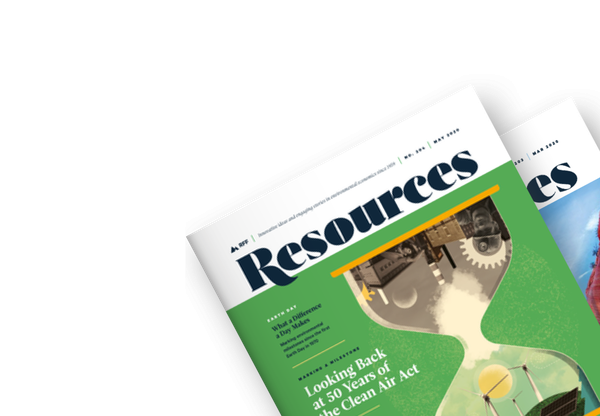If the federal government plans to repeal environmental regulations with the goal of cutting overall costs, then these decisions must consider the benefits as well as the savings.
On March 14, the new administrator of the US Environmental Protection Agency (EPA), Lee Zeldin, announced the reconsideration of regulations that cover power plants, cars, clean air and water standards, greenhouse gas reporting, and more. Amending or repealing regulations that do not provide a net benefit to the American people is a laudable goal, but informing the decisionmaking process will require careful analysis that uses transparent methodology.
During an analogous deregulatory push during the first Trump administration, researchers at Resources for the Future developed a methodology, based on transparent economic analysis, for what we can call regulatory repeal impact assessment (RRIA). This analysis of a proposed repeal would differ from a regulatory impact assessment (RIA), which happens before a regulation goes into effect and aims to evaluate whether that new regulation is likely to produce benefits greater than its costs. The purpose of RRIAs would be to inform EPA’s decisions about which rules are not delivering net benefits to the American people and therefore should be repealed (other things equal), and which rules are delivering net benefits and should be kept on the books (other things equal). We applied this methodology across multiple regulations, described in our full Should It Stay or Should It Go series of studies back in 2018. This type of approach is relevant as more repeals are on the table in the second Trump administration, which prompts a summary of this approach for evaluating repeals along with some key lessons learned.
If: EPA wants to repeal regulations that do not benefit the American people on net,
Then: the agency must implement a structured analysis to identify and assess the regulations that are being considered for repeal.
Methods
To generate an RRIA, our methodology follows these steps:
- Replicate the analysis from the original RIA. In our studies, we first replicated the analysis in the original assessment to be sure we understood all its assumptions, data, and algorithms for manipulating the data. EPA should take an inventory of whether spreadsheets and other underlying analyses are available to begin the RRIA process.
- Update the baseline from the original RIA. The RRIA should start from a baseline that reflects the impacts of the rule starting today, rather than when the rule was first analyzed and implemented. Updating the baseline could be a complex process, but at a minimum would involve using up-to-date forecasts of economic growth, population growth, and energy prices.
- Subtract the “sunk” costs and benefits of the rule. For instance, for one of the rules we assessed that required updated oil-tank railroad cars, many of the associated costs involved capital investments. But, to the extent those investments have already been made, such costs (and the cost savings of repeal) would not be appropriate to count in the RRIA.
- Update the analysis according to the latest available science. In the time since the original RIA was published, the scientific basis for the cost and benefit calculations may have evolved. For example, the accepted relationship between air pollution and human mortality might have changed since the original rule was issued, or innovations in materials manufacturing, pollution-capture technology, and the like may have advanced, reducing the costs of compliance (and the cost savings from repeal).
- Subtract the forgone benefits of repeal from the cost savings. If the cost savings exceed the forgone benefits, then the repeal has net benefits. If the forgone benefits exceed the cost savings, then the repeal has net costs.
Deciding on Which Rules to Repeal
In our prior work, we showed a critical distinction between considering the net benefits of a regulation versus only considering its costs, as the administration wants to do. Depending on which criterion gets used in RIAs, prioritizing regulations for reconsideration can lead to completely different recommendations for which rules to repeal.
In 2018, we completed six full RRIAs on energy regulations that we thought could be considered for repeal by the first Trump administration. Then, as now, the Trump administration’s plan was to repeal rules whose repeal would deliver the greatest cost savings. As noted, cost savings alone is not a proper criterion for repealing rules, which requires looking at both cost savings and forgone benefits. The more comprehensive approach of considering both cost savings and lost benefits even follows Circular A-4 as put forward by the Office of Management and Budget in 2003—guidance on regulatory analysis which has been endorsed by the second Trump administration. In our analysis of the six energy rules, we addressed the discrepancy in methodology by assessing the cost savings across the six rules compared to their net benefits.
The figures below, reproduced from our 2018 report, show how big a difference these two metrics would make in prioritizing which rules to repeal. (Note that differing assumptions for two of the rules led us to consider eight rules in total.) Figure 1 from the report shows that every rule ranks in a different order of priority for repeal, depending on which criteria are used in an RRIA.
Figure 1. Ranking Regulations That May Be Subject to Repeal, Under Two Paradigms

Notes: BLM = Bureau of Land Management, BOEM = Bureau of Ocean Energy Management, BSEE = Bureau of Safety and Environmental Enforcement, EPA = US Environmental Protection Agency, PHMSA = Pipeline and Hazardous Materials Safety Administration.
Figure 2 provides more detailed information, showing actual cost savings and net benefits that result from repealing each regulation. For instance, we found that repealing the EPA methane rule delivered by far the greatest cost savings—but when we considered the net benefits, that same rule ranked sixth in terms of the net benefits of its repeal.
Figure 2. Ranking Regulations That May Be Subject to Repeal, on a Numerical Scale Under Two Paradigms

Notes: BLM = Bureau of Land Management, BOEM = Bureau of Ocean Energy Management, BSEE = Bureau of Safety and Environmental Enforcement, EPA = US Environmental Protection Agency, PHMSA = Pipeline and Hazardous Materials Safety Administration.
Lessons Learned
In the course of redoing the six RIAs and turning them into RRIAs, we learned plenty of lessons that would be relevant for EPA’s reconsideration of rules.
- RRIAs, just like RIAs, require lots of judgement and assumptions. These analyses should be considered as information that can underlie a repeal decision, not as definitive.
- We found the six RIAs to be generally quite transparent in their assumptions and procedures, although parts of them required additional detective work. Clearly, RRIAs should be as transparent and complete as possible to increase public acceptance of decisions related to repeals.
- The RIAs reveal struggles in quantifying uncertainties and filling in data gaps. Those same struggles extend to doing RRIAs. A high-quality RIA results in a high-quality RRIA.
- Agencies struggle to quantify innovation and its effects on costs. Doing an RRIA for an old rule provides an opportunity to update the costs by accounting for recent innovations.
- One important baseline factor for RIAs, though rarely included, is state regulations. Updating RIAs with this information, or including state regulations in an RRIA, could be important.
- Compliance with rules generally is assumed when doing an RIA. However, where noncompliance has been significant, the cost savings of repeal of a regulation should not include noncompliant regulated entities. The benefits not realized from noncompliant entities also should not be counted in an RRIA as benefits forgone.
- Some rules actually contain deregulatory elements, so their repeal may reduce cost savings or even lead to the costs of repeal being larger than the cost savings from repeal.
- We also counseled agencies that were doing RRIAs to consider the options of partial repeal, no repeal, and complete repeal. Some provisions of a rule may deliver a large net benefit while others may have a net cost. Don’t throw the baby out with the bathwater.
Conclusion
This administration has proposed significant deregulatory actions. A thorough RRIA needs to be conducted on all 14 rules under consideration at EPA, and the assessments should follow established analytical procedures. These assessments take time and effort and care. But well-developed RRIAs will help establish the credibility of any actions taken to repeal regulations and defend them legally.

For more timely insights about developments in environmental and energy policy, browse the If/Then series.






